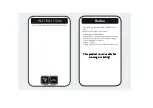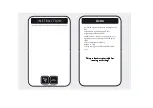
Troubleshooting
4-4
Troubleshooting Tips
• To aid in troubleshooting and to verify the integrity of the ion gauge
controller or the cold cathode gauge itself, one can use a resistive
dummy load. Obtain a 5.6 Meg ohm, 2 watt resistor. This value will
simulate a pressure reading in the mid E-3 Pa/E-5 Torr region;
higher resistor values than this will yield a lower pressure reading
and lower resistor values will yield a higher pressure reading.
• Varian offers reference ionization B/A gauges, which are sealed off
at approximately 6.6E-4Pa/5E-6 Torr. These gauges are extremely
helpful in troubleshooting a vacuum system problem by isolating the
defective component. It is important to know that these reference
ion gauge tubes are not NIST traceable calibrated gauges but act
only as a load for the ion gauge controller
WARNING
_____________
When connecting the resistive load to the back of the cold cathode
gauge controller, – 2000 volts DC will be present. Make sure the power
is off to the unit. Keep all conductive type of material away from the
back of the controller when troubleshooting.
The Customer is responsible for taking the necessary safety precau-
tions to avoid electrical shock when performing this test.
Programming Sensitivity
Varian offers reference ionization B/A gauges, which are sealed off at approximately 6.6E-4 Pa/5E-6 Torr.
These gauges are extremely helpful in troubleshooting a vacuum system problem by isolating the defec-
tive component. It is important to know that these reference ion gauge tubes are not NIST traceable cal-
ibrated gauges but act only as a load for the ion gauge controller.
Enter the Program mode by pressing the “Option Select” key. The first available parameter, beginning
from the top of the column and depending on the senTorr model and options installed, will flash in the
appropriate gauge display. Repeatedly pressing the “Option Select” key will advance through the para-
meters, returning the unit to the Run mode after the last key press.
When “Ion Sens” has been selected, the up and down arrow keys can be used to set a new value to
the flashing digit. The “Enter” key will advance the flashing through the digits, saving the new value
after the last digit has been set.






































